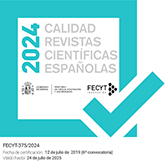Caracterización acústica de las róticas fricativas prepausales en español peninsular
DOI:
https://doi.org/10.3989/loquens.2015.019Palabras clave:
róticas, fricativas, caracterización acústica, vibrantesResumen
El objetivo de este estudio es presentar una caracterización acústica de las consonantes róticas prepausales realizadas con un único componente fricativo en español peninsular. Para ello, se analizaron cuatro variables acústicas que dan cuenta de su estructura espectral (esto es, centro de gravedad, desviación estándar, asimetría y apuntamiento) y la duración. Los resultados del análisis se compararon estadísticamente con las características espectrales de las consonantes fricativas /s/ (con las que comparten punto de articulación) en la misma posición. Se han hallado diferencias estadísticamente significativas en las cinco variables, siendo el centro de gravedad en las fricativas superior en unos 2600 Hz al centro de gravedad de las róticas. Las fricativas alveolares también muestran un resultado superior en la desviación estándar y en la duración. Por el contrario, con respecto al apuntamiento y a la asimetría, los sonidos fricativos muestran valores inferiores. Finalmente, mediante el análisis lineal discriminante, se ha logrado un porcentaje de clasificaciones correctas superior al 94 % teniendo en cuenta únicamente como variables discriminantes el centro de gravedad y la asimetría.
Descargas
Citas
Argüello, F. M. (1978). The ?eísta dialect of Spanish spoken in Ecuador: A phonetic and phonological study (tesis doctoral). The Pennsylvania State University.
Barreiro Bilbao, S. C. (1999–2000). Análisis acústico comparado de las fricativas castellanas no sibilantes en realizaciones aisladas. Contextos, 33–36, 243–261.
Blecua, B. (1999). Características acústicas de la vibrante múltiple del espa-ol en habla espontánea. En Actas del I Congreso de Fonética Experimental (pp. 119–126). Tarragona: Servei de Publicacions, Universitat de Barcelona y Universitat Rovira i Virgili.
Blecua, B. (2001). Las vibrantes del espa-ol: Manifestaciones acústicas y procesos fonéticos (tesis doctoral). Bellaterra: Universitat Autònoma de Barcelona. Disponible en http://hdl.handle.net/10803/4859
Blecua, B. (2006). Estudio acústico de la vibrante en posición implosiva. En Filología y lingü.stica. Estudios ofrecidos a Antonio Quilis (vol. 1), pp. 97–112. Madrid: CSIC, UNED y Universidad de Valladolid.
Blecua, B., Cicres, J., & Gil, J. (en prensa). Variación en las róticas del espa-ol y su implicación en la identificación del locutor. Revista de Filología Románica, Anejo 8 (2014): Estudios de fonética y fonología románicas.
Bradley, T. G. (2001). The phonetics and phonology of rhotic duration contrast and neutralization (tesis doctoral). The Pennsylvania State University.
Bradley, T. G. (2004). Gestural timing and rhotic variation in Spanish codas. En T. L. Face (Ed.), Laboratory approaches to Spanish phonology (pp. 195–220). Berlin: Mouton de Gruyter.
Bradley, T. G. (en prensa). Consonantes róticas: Descripción fonética. En J. Gil & J. Llisterri (Eds.), Fonética y fonología descriptivas de la lengua espa-ola (cap. 21). Madrid: Consejo Superior de Investigaciones Científicas. Disponible en https://www.academia.edu/7095921/Consonantes_r%C3%B3ticas_Descripci%C3%B3n_fon%C3%A9tica
Bradley, T. G., & Willis, E. W. (2012). Rhotic variation and contrast in Veracruz Mexican Spanish. Estudios de Fonética Experimental, 21, 43–74.
Canfield, D. L. (1981). Spanish pronunciation in the Americas. Chicago, IL: University of Chicago Press.
Cerdà, R. (1968). Algunas observaciones en torno a la definición de «-r» espa-ola. Boletín de Filología Espa-ola, 7(26–27), 19–24.
Cicres, J. (2011). Los sonidos fricativos sordos y sus implicaciones forenses. Estudios Filológicos, 48, 33–48. http://dx.doi.org/10.4067/S0071-17132011000200003
Colantoni, L. (2001). Mergers, chain shifts, and dissimilatory processes: Palatals and rhotics in Argentine Spanish (tesis doctoral). Minneapolis: University of Minnesota.
Fernández, S., Feijóo, S., Balsa, R., & Barros, N. (1998). Acoustic cues for the auditory identification of the Spanish fricative /f/. En Proceedings of the International Conference on Spoken Language Processing (ICSLP '98), 5, 2151–2154.
Forrest, K., Weismer, G., Milenkovic, P., & Dougall, R. N. (1988). Statistical analysis of word-initial voiceless obstruents: Preliminary data. Journal of the Acoustical Society of America, 84, 115–124. http://dx.doi.org/10.1121/1.396977
Fu, H., Rodman, R. D., McAllister, D. F., Bitzer, D. L., & Xu, B. (1999). Classification of voiceless fricatives through spectral moments. En Proceedings of the 5th International Conference on Information Systems Analysis and Synthesis (ISAS '99), pp. 307–311. Skokie, IL: International Institute of Informatics and Systemics.
García Antu-a, M. (2012). Análisis acústico-sonográfico de las consonantes róticas (/r/ y /?/) para su aplicación en entornos de estudios forenses (trabajo de fin de máster). Alcalá de Henares: Instituto Universitario de Investigación en Ciencias Policiales. Facultad de Derecho, Universidad de Alcalá de Henares.
Gili Gaya, S. (1921). La «r» simple en la pronunciación espa-ola. Revista de Filología Espa-ola, 8, 271–280.
Griffin, D. (1965). Rotacismo y aspiración: Una nota sobre cronología dialectal. Boletín de Filología, 17, 407–411.
Henriksen, N. C., & Willis, E. W. (2010). Acoustic characterization of phonemic trill production in Jerezano Andalusian Spanish. En M. Ortega-Llebaria (Ed.), Selected Proceedings of the 4th Conference on Laboratory Approaches to Spanish Phonology (pp. 115–127). Somerville, MA: Cascadilla Proceedings Project.
Hualde, J. I. (2005). The sounds of Spanish. Cambridge, UK: Cambridge University Press.
Jongman, A., Wayland, R., & Wong, S. (2000). Acoustic characteristics of English fricatives. Journal of the Acoustical Society of America, 108(3), 1252–1263. http://dx.doi.org/10.1121/1.1288413
Lenz, R. (1892). Chilenische Studien. Phonetische Studien, 5, 272–293.
Lindau, M. (1985). The story of /r/. En V. A. Fromkin (Ed.), Phonetic linguistics. Essays in honour of Peter Ladefoged (pp. 157–168). Orlando, FL: Academic Press.
Lope Blanch, J. M. (1978). Una nota sobre los sonidos vibrantes. Anuario de Letras, 16, 247–250.
Malmberg, B. (1965). Estudios de fonética hispánica: Collectanea Phonetica (vol. 1). Madrid: CSIC.
Martínez Celdrán, E. (1984). Fonética. Barcelona: Teide.
Martínez Celdrán, E., & Fernández Planas, A. M. (2007). Manual de fonética espa-ola. Articulaciones y sonidos del espa-ol. Barcelona: Ariel.
Martínez Celdrán, E., & Rallo, L. (1995). [?-r]: ¿Dos clases de sonidos? Estudios de Fonética Experimental, 7, 181–193.
Massone, M. I. (1988). Estudio acústico y perceptivo de las consonantes nasales y líquidas del espa-ol. Estudios de Fonética Experimental, 3, 13–34.
Morgan, T., & Sessarego, S. (en prensa). A phonetic analysis of /r/ in Highland Bolivian Spanish. Spanish in Context, 13(2).
Navarro Tomás, T. (1918/1985). Manual de pronunciación espa-ola (22.ª ed.). Madrid: CSIC.
Quilis, A. (1993). Tratado de fonología y fonética espa-olas. Madrid: Gredos.
Quilis, A., & Carril, R. B. (1971). Análisis acústico de [?] en algunas zonas de Hispanoamérica. Revista de Filología Espa-ola, 59(3–4), 271–316. http://dx.doi.org/10.3989/rfe.1971.v54.i3/4.844
Real Academia Espa-ola (2011). Nueva gramática de la lengua espa-ola. Vol. 3: Fonética y fonología. Madrid: Espasa.
Recasens, D. (1991). On the production characteristics of apicoalveolar taps and trills. Journal of Phonetics, 19, 267–280.
Recasens, D. (1993). Fonètica i fonologia. Barcelona: Enciclopèdia Catalana.
Recasens, D., & Pallarès, M. D. (1999). A study of /?/ and /r/ in the light of the "DAC" coarticulation model. Journal of Phonetics, 27(2), 143–169. http://dx.doi.org/10.1006/jpho.1999.0092
Rodríguez Castellano, L. (1952). La variedad dialectal del Alto Aller. Oviedo: Instituto de Estudios Asturianos.
Romero, J. (2008). Gestural timing in the perception of Spanish r+c clusters. En L. Colantoni & J. Steele (Eds.), Selected Proceedings of the 3rd Conference on Laboratory Approaches to Spanish Phonology (pp. 59–71). Somerville, MA: Cascadilla Proceedings Project.
Sessarego, S. (2011). Phonetic analysis of /sr/ clusters in Cochabambino Spanish. En L. A. Ortiz-López (Ed.), Selected Proceedings of the 13th Hispanic Linguistics Symposium (pp. 251–263). Somerville, MA: Cascadilla Proceedings Project.
Walsh Dickey, L. (1997). The phonology of liquids (tesis doctoral). Disponible en ProQuest (tesis n.º AAI9721443).
Zahler, S., & Daidone, D. (2014). A variationist account of trill /r/ usage in the Spanish of Málaga. IULC Working Papers: Special Vol.: Quantitative approaches to the study of sociolinguistic phenomena across Spanish varieties, 14(2), 17–42. Blomington: Indiana University Working Papers in Linguistics.
Zsiga, E. (1993). Features, gestures, and the temporal aspects of phonological organization (tesis doctoral). New Haven, CT: Yale University.
Publicado
Cómo citar
Número
Sección
Licencia
Derechos de autor 2015 Consejo Superior de Investigaciones Científicas (CSIC)

Esta obra está bajo una licencia internacional Creative Commons Atribución 4.0.
© CSIC. Los originales publicados en las ediciones impresa y electrónica de esta Revista son propiedad del Consejo Superior de Investigaciones Científicas, siendo necesario citar la procedencia en cualquier reproducción parcial o total.
Salvo indicación contraria, todos los contenidos de la edición electrónica se distribuyen bajo una licencia de uso y distribución “Creative Commons Reconocimiento 4.0 Internacional ” (CC BY 4.0). Consulte la versión informativa y el texto legal de la licencia. Esta circunstancia ha de hacerse constar expresamente de esta forma cuando sea necesario.
No se autoriza el depósito en repositorios, páginas web personales o similares de cualquier otra versión distinta a la publicada por el editor.














